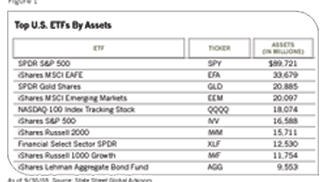Investors received a cruel reminder of just how important the credit strength of the issuer is when Lehman Brothers collapsed, leaving those with stakes in its three ETNs likely to receive a fraction of what they paid.
Gary Gastineau, a principal of ETF Consultants, believes the pricing issues with bond ETFs are mainly technical in nature and "will not be a significant obstacle to growth." On the other hand, ETNs may take longer to recover. "The number of new ETN offerings has dropped sharply, and there is a lot of liquidation in existing issues. You've got falling commodity prices and credit issues coming together, and the combination is pretty toxic."
What to Look for In 2009
Emerging markets and narrowly slivered sectors of the market dominated the ETF landscape in 2007, and the offerings this year reflected people's growing appetite for investments with a low correlation to the stock market. Look for a number of trends to develop in 2009 such as more
slicing and dicing. Expect further expansion of the ETF and ETN investment universe, as well as more rules-based indexes created specifically for these products.
As of October, there were 535 ETFs and ETNs in registrations covering all areas of the market, including sector and country allocations, target dates, inverse and leveraged funds and state-specific bond funds.
David Krein, a senior director of institutional markets for Dow Jones Indexes, says ETF providers will continue to offer more exposure to far-flung corners of the globe such as Africa and the Middle East, as well as leveraged, non-dollar and inverse exposure to the commodities markets. "Advisors are looking to expand their core allocations and make more tactical bets, and new products will make that easier," he says.
Asset allocation and target-date funds. Straddling both sides of the fence, ETFs will also try to appeal to the segment of the market looking for greater simplicity. In June, TD Ameritrade and XShares began offering target-date ETFs under the TDAX banner. Both Standard & Poor's and Dow Jones have recently devised target-date indexes that could eventually become the basis for ETFs. And State Street Global Advisors has filed a series of target-date ETFs with the Securities and Exchange Commission. These would join a handful of target-date mutual funds that use ETFs as the basis for their portfolios.
ETFs in 401(k) plans. Although many believe that the biggest potential for growth in the ETF industry lies in cracking the 401(k) market, so far these retirement plans remain solidly in mutual fund territory. Those opposed to offering ETFs in this space cite the funds' administrative issues, transaction costs, bid/ask spreads and brokerage commissions as deterrents. Lydon observes that fund companies have little incentive to sacrifice the higher fees they get from mutual funds by moving participants into lower-cost ETFs. "If you take away 401(k) plans, the money going into mutual funds and ETFs is about the same, so there is a lot at stake here," he says.
Still, some signs indicate that the 401(k) market is slowly opening up to ETFs and will continue to do so, albeit slowly. In early October, WisdomTree announced a 401(k) platform that includes ETFs and other investment vehicles, saying the funds would offer investors flexibility, benchmark neutrality and low costs. Darwin Abrahamson, CEO of Invest n Retire, which specializes in 401(k) platforms for ETFs, says that new requirements by the Department of Labor mandating greater disclosure of revenue-sharing arrangements and fees will make it more likely that ETFs will be included in 401(k) plans. "There are a lot of fund expense lawsuits out there, and with these new reporting and disclosure requirements companies are going to want to look at investment options that don't have all that baggage," he says.
Actively managed ETFs hold a number of potential advantages over their mutual fund counterparts. Investment management fees are inevitable in an actively managed portfolio, but fees on the ETFs, which do not have to service shareholder accounts, would likely be lower than those in traditional mutual funds. They would probably be more tax efficient, too, and unlike many mutual funds, which require a 30-day holding period, they would have no minimum holding time.
Yet ETFs have also had a slow start, in part because of transparency requirements that compel fund managers to reveal and update portfolio holdings daily, with minimal lag time. By contrast, mutual funds usually report holdings on a quarterly basis and often do so weeks after the end of the reporting period. Although transparency requirements are a major hurdle for fund managers, mutual fund giants PIMCO, Vanguard and iShares have all filed with the SEC for approval to launch actively managed ETFs. If these are well-received, other mutual fund companies that have been sitting on the sidelines may follow their lead to remain competitive.









